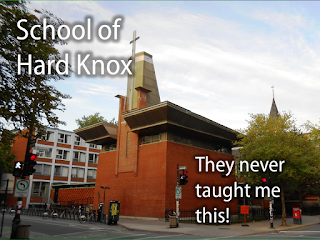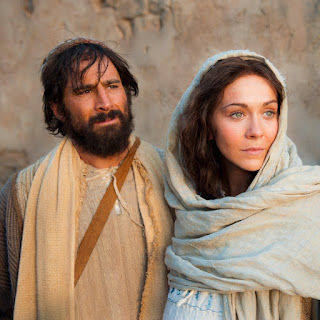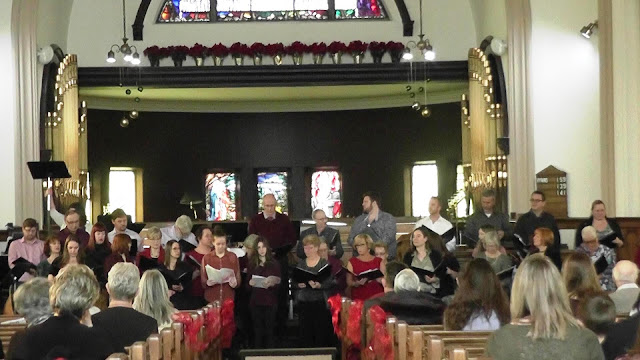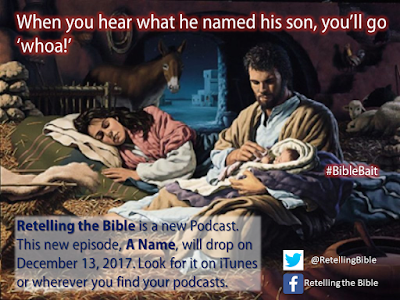Hespeler, 4 February, 2018 © Scott McAndless
Matthew 5:43-48, Galatians 4:1-7, Psalm 27:4-14
| W |
hen we pray to God and call God, “Our Father,” you all get that that is a metaphor, right? I mean, we all understand that we don’t mean that literally. We’re not saying that God is our literal or biological or even foster father, but that, in some meaningful ways, God is like a good human father. It’s a metaphor. And it is, in many ways, a good metaphor – a metaphor that genuinely helps lots of people to see God in a helpful way. But we also understand that, like most metaphors, you cannot push it too far. You should not take that metaphor as an indication that God is human or male or likes to smoke a pipe and read the Sport’s Section even if every father you have ever known has been human, male, a pipe-smoker and a sports fan.
What’s more, I think we can all recognize that it is a metaphor that doesn’t work as well for some people as it does for others. Some people, frankly, don’t really have the best experience with human fathers. Some children don’t grow up even knowing a father or have been abandoned by him at a very early age. You can well imagine that, for such a person, calling God Father doesn’t necessarily help them to engender the warmest feelings for God. You could hardly blame such a person if their image of a Father God is someone distant or absent. And, of course, I hardly need to say that if someone had an abuser, an addict or a criminal as a father they would naturally have a very warped view of any God they called Father. That is the thing with metaphors. They are very powerful, but they are sometimes too powerful – so powerful that that they lead people down false paths instead of towards the truth.
But here is something that you may not have thought of before: when we call God Father, we have all kinds of ideas and images that we associate with that metaphor, some of them helpful and some of them not so helpful. But what if I were to tell you that the ideas that we associate with that metaphor are not exactly the same ones that Jesus, his disciples and the people who wrote the Bible had? I mean, we all realize that on some level that the Bible was written in a very different world from the one where we find ourselves. But one thing that means is that words didn’t mean exactly the same thing back then as they do now.
The Bible was written in a patriarchal society. And I know that we often use that word “patriarchy” today to refer to the power that men hold in society in general. But the word actually means something much more specific than that. The word literally means “father-rule” and it means that the most basic and fundamental organising principle of that kind of society is the father. It means that everyone in the entire society belongs, in some sense, to a family and that each family is under the control of one powerful male individual. Fathers rule in the sense that absolutely everyone in society must answer to a father somewhere.
And, as you have probably already imagined, there can be a downside to that sort of a structure in society, at least for those who don’t get to be the fathers. Fathers are given near absolute power. They can tell any member of their family what to do, who to marry, control most every aspect of their lives and even have the power of life or death with few limitations. The father, in such a society is an absolute dictator and you can easily imagine that many fathers could and did abuse that kind of power.
But there was also a bright side to this structure – after all, how could it endure so long if people didn’t see some benefits. There was also a clear understanding that this amazing amount of power and authority given to a father could only be used to one purpose: to ensure that every member of the household had what they needed to survive and to thrive. The system wasn’t there in order to serve the fathers, at least not in theory. It was there to protect, support and bless the entire family.
And that family could include an awful lot of people. It wasn’t just what we call a family today – the basic family unit of parents and offspring living together under one roof. It was an extended family that might include multiple generations and various degrees of relation. A family also included slaves, servants and hired workers on the farm and it even included livestock and working animals. The father was responsible for all of those people and not merely responsible to keep them alive and fed, but responsible to see that each and every one of them had what they needed to meet their highest potential.
Now, if that sounds like way too heavy a burden for any individual to bear, it absolutely is. How could one person know enough about every individual in his household to know exactly what each one needs to thrive? And how could he find the means and resources to make that happen?
The evidence seems to indicate that fathers suffered a great deal in order to meet such impossible expectations. They had a terrible life expectancy; they worked themselves to death. And the stress of the job manifested in many other ways. I am sure that many of the men that Jesus healed in his ministry – the so-called demon possessed, the paralytics, the hysterically blind – were men who had been overwhelmed by all the expectations that were put upon them and upset at their failure to meet those expectations in the midst of an economic crises that had been caused by Roman greed. The stresses on them were so extreme that they had started to manifest in physical ailments; their bodies literally began to shut down.
But there didn’t seem to be any escaping it; it was just the way that the world worked. Fathers were given an extraordinary amount of power, but not really enough power if they were going to live up to everything that was expected of them.
But then, we’re told, Jesus came along. And Jesus spoke about a different way of doing things – of a kingdom that belonged to God rather than to any human power or authority – including fathers. (Jesus even once explicitly said that there should be no “fathers” in his entire movement.) And perhaps the greatest indication of the radical newness of this kingdom that Jesus spoke of was the way that he talked about God. Jesus, you see, called God his father and he taught his disciples to pray and do likewise.
Now, Jesus wasn’t the first person to ever think of calling God a father. That is indeed a very ancient idea – that, just like a father ruled over a family, maybe God ruled over the whole world. In other words, they took their understanding of how the world worked below (where fathers ruled with iron hands) and mapped that onto heaven.
What is unique about Jesus isn’t just the fact that he called God father, it is the way that he did it and what he meant when he said it. The passage we read from the Sermon on the Mount this morning is perfect example of how he used the word. “But I say to you, Love your enemies and pray for those who persecute you, so that you may be children of your Father in heaven; for he makes his sun rise on the evil and on the good, and sends rain on the righteous and on the unrighteous.”
The image of a father that Jesus is using there is the common image of a father in his society. It is that father overlooking a large household that includes many people from every level of society. The only difference is that the household is so large that it actually encompasses the whole earth. That alone, is not unusual. People had spoken of God in those terms before but that image had always been about how God’s authority extended over the world like a father’s authority was exercised over his whole family. It was a God-as-absolute-tyrant image.
But you can tell from the way that Jesus uses that image, that that is not what he has in mind. Instead of authority, Jesus puts his emphasis on that huge burden of care that a father bore for every person in his household. Jesus says that God, as father, takes very seriously that need to make sure that every member of his household, which encompasses the whole world, has what they need not merely to survive but to thrive. And, as father, God does not have the luxury of playing favourites. He must pour out his blessing – his rain and his sunshine – on those that the world sees as good, and those who the world sees as evil. These gifts must be for the righteous and the unrighteous alike. He must take all of them as they are and do what is best for each person to meet his or her potential.
And that was indeed a revolutionary idea. It opened the door to so much of where the Christian faith went from there. If God was that kind of father and if the household that he was looking after was as wide as the whole world, then many of the old notions that people had about how God related to the people he had created had to be broken down. No more could hope and salvation just be restricted to one ethnic group, the Jews. Surely a loving father would not want to exclude any member of his family from salvation; and so the barrier between Jew and Gentile was broken down.
In the same way, if God, like that ideal ancient father, was really committed to giving the best opportunities for all his children no matter who they were, then surely God’s concern for them wouldn’t be limited by social status. Rich or poor, slave or free, noble or peasant, God would seek the best for all and so the barriers between slave and free would be demolished. Nor would God care all that much about things like gender, so the barrier between male and female would fall. These were all radical ideas for the times, and yet they were reached for in the early Christian church, as we see in the writings of the New Testament. These radical ideas had their origins in the unique way in which Jesus spoke of God. The metaphor is that powerful.
I hope that many of you were blessed, as I have been, with a good father who was involved in your life, who tried to give his very best for his family. When you have someone like that in your life, it helps you to grow up with a strong sense of who you are and of security – that everything is going to be alright. If you got that from someone who is or was a father in your life, then, when you imagine God and speak to God as a Heavenly Father, you will automatically make all of those associations with God in your own mind. It will help you to approach all of life with a strong sense of yourself and of security – a great foundation for a good life.
Of course, if you didn’t have that kind of presence in your life, you may not get very much from the imagery of a Father God – you may even get very negative associations. That is alright. There isn’t anything wrong with you because the metaphor doesn’t help you to better know God. And if meditating on the image of a Heavenly Father doesn’t help you to grow closer to God, it is okay to find other imagery that does that for you. There is nothing wrong with speaking to God as mother, as caregiver, as friend if those images do help you towards a deeper and more positive understanding of the God who cares about you.
So don’t underestimate the power of a metaphor. The way that Jesus could talk about God as his father actually changed the world. It offered peace and hope to people who were struggling to find their way in a very difficult time. We don’t necessarily need to be wedded to particular metaphors, but I would hope that we, like Jesus and the early church, could find the courage to speak about the God that we have come to know through Jesus and say what that God is like. Such talk still has the power to change the world.











